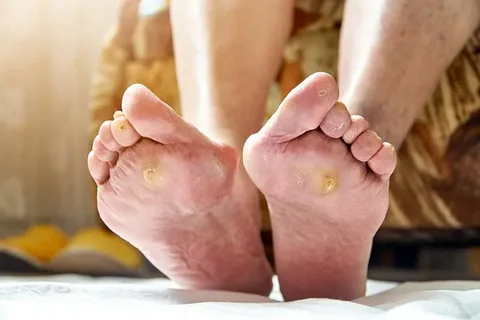CGM also has the potential to contribute significantly to the early detection of diabetic foot ulcers that may turn into complications whose solutions may be costly to offer to the patients treated.
What is a diabetic foot ulcer or (DFU)?
Diabetic foot ulcers, usually called DFU, are a common severe complication of diabetes that can affect people with diabetes. They include ulcers that open up between the foot and the skin in areas like the sole, the heel, and the instep of the foot.
These are usually caused by several factors in diabetes involving neuropathy, which is nerve damage resulting from diabetes. This leads to reduced sensations in the feet and poor circulation, which makes the body’s healing process difficult. It enhances the risk of infection in the body.
Wounds can vary from small, superficial, or shallow wounds to larger, deeper wounds, which are always at the risk of becoming infected, leading to necrosis or, ultimately, amputations when not properly and promptly addressed. Hence, people suffering from diabetes should ensure that they take good care of their feet and regularly monitor them to avoid the formation of such catastrophic ulcers.
Causes and risk factors
As a rule, the formation of diabetic foot ulcers is usually associated with prolonged uncontrolled diabetes, which results in numerous physiological abnormalities that predispose to the development of ulcers. Here are some causes and risk factors associated with diabetic foot ulcers:
- Peripheral neuropathy
Diabetic peripheral neuropathy is one of the most commonly encountered complications of diabetes where the nerves of the extremities and the feet, in particular, are damaged.
The neuropathy could result in a loss of sensation called neuropathic anesthesiology, which means you might be unable to feel pain, pressure, or temperature changes in your feet. Consequently, they may be unaware of sores such as ulcers and pressure areas.
- Poor circulation
Poor circulation is also another effect of diabetes, which is known as peripheral artery disease or PAD. Lower blood supply can reduce the body’s ability to heal and make it difficult for oxygen and nutrients to get into damaged tissues, complicating the wound-healing process.
- Trauma and pressure
Increased pressure or friction in the feet, as may be caused by poorly fitting footwear or deformities like bunions and hammertoes, may result in skin breakdown or ulcers. This pressure or injury might be felt by individuals only after the injury has developed in combination with neuropathy.
- Infection
The weakened immune system and slow healing of wounds make people with diabetes more susceptible to infections. An ulcer can open up as a passageway for bacteria and make it difficult to treat infections to be treated.
- Control blood sugar levels
Poor blood sugar can decrease the body’s capacity to fight infections and heal wounds if not controlled well for a long time. High blood sugar may also harm blood vessels and nerves, increasing the possibility of an ulcer.
- Poor foot care
Ulcers can develop due to improper hygiene and bad care of the foot. It is also necessary regularly to check and clean up feet.
Consequences of untreated DFU
Untreated diabetic foot ulcers (DFUs) will result in many complications. Diabetes, as a result, impacts blood circulation and hinders the body’s ability to repair itself, so a small scratch in the foot becomes an important difficulty. If left unchecked, DFUs may develop into cellulitis, deepening in tissue infections like osteomyelitis. Untreated DFUs may sometimes advance to gangrene, which may call for amputation of the affected limb to stop the infection from spreading to other body parts. In addition, DFUs that are not handled correctly increase the likelihood of contracting fatal infections like sepsis. As such, early detection and urgent medical care can prove decisive in avoiding the severe implications of left-untreated DFUs.
How CGM can help detect DFU early
Continuous glucose monitoring (CGM) technology is crucial in the early identification of diabetic foot ulcers (DFU) by providing real-time knowledge about a patient’s blood sugar levels and diabetes. CGM devices monitor glucose levels 24/7, offering a more complete picture of the fluctuation of blood sugars compared with standard finger stick tests. With this monitoring, people with diabetes can identify blood sugar patterns and take action to maintain their blood sugar levels within healthy limits. Patients could lower the risk of complications such as DFU by maintaining better glycemic control.
Furthermore, this system allows patients and health care providers to monitor glucose levels and thus identify any signs of potential risks that may develop into Diabetic Foot Ulceration. Such changes can result in neuropathy and poor circulation, resulting in the development of DFU. Secondly, the use of CGM technology provides a feedback loop that involves the patient. This makes the patient active and more attentive to managing their diabetes. CGM helps achieve early identification of UUPs by patients, possibly preventing their occurrence and minimizing health care expenses that come with the related complications.
Is it worth investing in CGM for early detection of diabetic foot ulcers?
Indeed, investing in a Continuous Glucose Monitoring (CGM) system might make sense to detect foot ulcers early for diabetics.
With CGM, you can monitor your blood sugar changes second by second. For people with diabetes, this is important because chronic hyperglycemia may result in neuropathy and poor circulation. These factors increase the risk of diabetic foot ulcers.
Using a CGM helps you manage your blood sugar levels and stop the complications that produce foot ulcers. It is crucial as once an individual develops a foot ulcer, it becomes hard to treat, sometimes worsening, leading to serious infection or even amputation. Purchasing a CGM can be a proactive measure in managing diabetes and promoting good foot health.
Conclusion
Through continuous monitoring of blood glucose, CGM devices assist individuals with diabetes and health professionals in managing and keeping track of the disease.
Keeping blood sugar levels steady can considerably decrease the chances of complications such as diabetic foot ulcers by helping to promote good foot health generally. Thus, CGM technology is helpful in actively managing the condition that makes one lose function ability.





